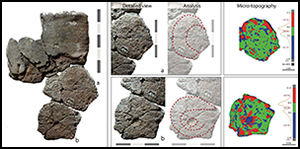Crossref Citations
This article has been cited by the following publications. This list is generated based on data provided by
Crossref.
Kozatsas, Jannis
Kotsakis, Kostas
Sagris, Dimitrios
and
David, Konstantinos
2018.
Inside out: Assessing pottery forming techniques with micro-CT scanning. An example from Middle Neolithic Thessaly.
Journal of Archaeological Science,
Vol. 100,
Issue. ,
p.
102.
Gomart, Louise
Weiner, Allon
Gabriele, Marzia
Durrenmath, Gilles
Sorin, Sabine
Angeli, Lucia
Colombo, Marta
Fabbri, Cristina
Maggi, Roberto
Panelli, Chiara
Pisani, Didier F.
Radi, Giovanna
Tozzi, Carlo
and
Binder, Didier
2018.
Spiralled patchwork in pottery manufacture and the introduction of farming to Southern Europe—ERRATUM.
Antiquity,
Vol. 92,
Issue. 361,
p.
277.
Gabriele, Marzia
Convertini, Fabien
Verati, Chrystele
Gratuze, Bernard
Jacomet, Suzanne
Boschian, Giovanni
Durrenmath, Gilles
Guilaine, Jean
Lardeaux, Jean-Marc
Gomart, Louise
Manen, Claire
and
Binder, Didier
2019.
Long-distance mobility in the North-Western Mediterranean during the Neolithic transition using high resolution pottery sourcing.
Journal of Archaeological Science: Reports,
Vol. 28,
Issue. ,
p.
102050.
Park, Ki Suk
Milke, Ralf
Rybacki, Erik
and
Reinhold, Sabine
2019.
Application of Image Analysis for the Identification of Prehistoric Ceramic Production Technologies in the North Caucasus (Russia, Bronze/Iron Age).
Heritage,
Vol. 2,
Issue. 3,
p.
2327.
Inácio, Nuno
Gonçalves, Victor S.
and
Sousa, Ana Catarina
2019.
Technology and mobility: First pottery productions in western Iberian Peninsula (Tagus estuary, Portugal).
ArchéoSciences,
Vol. 43-2,
Issue. ,
p.
149.
Drieu, L.
Horgnies, M.
Binder, D.
Pétrequin, P.
Pétrequin, A.‐M.
Peche‐Quilichini, K.
Lachenal, T.
and
Regert, M.
2019.
Influence of porosity on lipid preservation in the wall of archaeological pottery.
Archaeometry,
Vol. 61,
Issue. 5,
p.
1081.
Pardo-Gordó, Salvador
García Rivero, Daniel
and
Bernabeu Aubán, Joan
2019.
Evidences of branching and blending phenomena in the pottery decoration during the dispersal of the Early Neolithic across Western Europe.
Journal of Archaeological Science: Reports,
Vol. 23,
Issue. ,
p.
252.
Roux, Valentine
2019.
Ceramics and Society.
p.
15.
Perlès, Catherine
2020.
Trois décennies de recherche : une archéologie préhistorique plus proche de l’humain..
Histoire de la recherche contemporaine,
Vol. Tome IX - n°2,
Issue. ,
p.
125.
Rivollat, Maïté
Jeong, Choongwon
Schiffels, Stephan
Küçükkalıpçı, İşil
Pemonge, Marie-Hélène
Rohrlach, Adam Benjamin
Alt, Kurt W.
Binder, Didier
Friederich, Susanne
Ghesquière, Emmanuel
Gronenborn, Detlef
Laporte, Luc
Lefranc, Philippe
Meller, Harald
Réveillas, Hélène
Rosenstock, Eva
Rottier, Stéphane
Scarre, Chris
Soler, Ludovic
Wahl, Joachim
Krause, Johannes
Deguilloux, Marie-France
and
Haak, Wolfgang
2020.
Ancient genome-wide DNA from France highlights the complexity of interactions between Mesolithic hunter-gatherers and Neolithic farmers.
Science Advances,
Vol. 6,
Issue. 22,
Mazzucco, Niccolò
Ibáñez, Juan José
Capuzzo, Giacomo
Gassin, Bernard
Mineo, Mario
Gibaja, Juan Francisco
and
Biehl, Peter F.
2020.
Migration, adaptation, innovation: The spread of Neolithic harvesting technologies in the Mediterranean.
PLOS ONE,
Vol. 15,
Issue. 4,
p.
e0232455.
Delhon, Claire
Binder, Didier
Verdin, Pascal
and
Mazuy, Arnaud
2020.
Phytoliths as a seasonality indicator? The example of the Neolithic site of Pendimoun, south-eastern France.
Vegetation History and Archaeobotany,
Vol. 29,
Issue. 2,
p.
229.
Derenne, Eve
Ard, Vincent
and
Besse, Marie
2020.
Pottery technology as a revealer of cultural and symbolic shifts: Funerary and ritual practices in the Sion ‘Petit-Chasseur’ megalithic necropolis (3100–1600 BC, Western Switzerland).
Journal of Anthropological Archaeology,
Vol. 58,
Issue. ,
p.
101170.
Nicolas, Théophane
2020.
De l’analyse tomodensitométrique à la caractérisation des chaînes opératoires et des matériaux de la céramique.
Les Nouvelles de l'archéologie,
p.
60.
Thér, Richard
2020.
Ceramic technology. How to reconstruct and describe pottery-forming practices.
Archaeological and Anthropological Sciences,
Vol. 12,
Issue. 8,
Drieu, Léa
Lepère, Cédric
and
Regert, Martine
2020.
The Missing Step of Pottery chaîne opératoire: Considering Post-firing Treatments on Ceramic Vessels Using Macro- and Microscopic Observation and Molecular Analysis.
Journal of Archaeological Method and Theory,
Vol. 27,
Issue. 2,
p.
302.
Zidane, F.
Migliaccio, C.
Lanteri, J.
Brochier, L.
Coli, V.L.
Binder, D.
and
Gomart, L.
2020.
Sorting of Archaeological Samples in D-band.
p.
1801.
Drieu, Léa
Lucquin, Alexandre
Cassard, Laura
Sorin, Sabine
Craig, Oliver E.
Binder, Didier
and
Regert, Martine
2021.
A Neolithic without dairy? Chemical evidence from the content of ceramics from the Pendimoun rock-shelter (Castellar, France, 5750–5150 BCE).
Journal of Archaeological Science: Reports,
Vol. 35,
Issue. ,
p.
102682.
Manen, C
Perrin, T
Guilaine, J
Bouby, L
Bréhard, S
Briois, F
Durand, F
Marinval, P
and
Vigne, J-D
2021.
THE SPREAD OF FARMING ECONOMY IN THE WESTERN MEDITERRANEAN: A SHORT REPLY TO AMMERMAN (2021).
Radiocarbon,
Vol. 63,
Issue. 3,
p.
751.
Cámara Manzaneda, Javier
Clop García, Xavier
García Rosselló, Jaume
Camalich Massieu, María Dolores
and
Martín-Socas, Dimas
2021.
Manufacturing traces and pot-forming processes during the Early Neolithic at Cueva de El Toro (Málaga, Spain, 5280–4780 BCE).
Journal of Archaeological Science: Reports,
Vol. 37,
Issue. ,
p.
102936.


